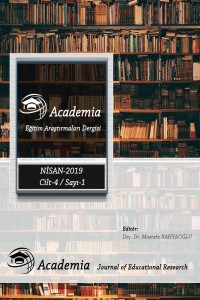Lise Öğrencilerinin STEM Alanlarına Yönelik Kariyer İlgileri ve Tutumlarının Demografik Değişkenler Açısından İncelenmesi
Abstract
Bu çalışmada lise
öğrencilerinin STEM alanlarına yönelik kariyer ilgileri ve tutumlarının
cinsiyet ve STEM derslerindeki akademik başarı düzeyleri açısından incelenmesi
amaçlanmıştır. 2018 öğretim yılı içerisinde İzmir ili merkezinde 1656 lise
öğrencisinin katılımı ile yürütülen bu çalışmada “Durum Araştırması” yöntemi
benimsenmiştir. Evrenini İzmir ili merkezinde öğrenim gören lise öğrencilerinin
oluşturduğu çalışmanın, örneklimi Zıt tabakalı örnekleme yöntemine göre
belirlenmiştir. Bu bağlamda İzmir ili merkezinde eğitim öğretim faaliyeti
yürüten liseler arasından 2016 TEOG puanlarına göre en yüksek ve düşük puanlı
olacak şekilde 2 fen lisesi, 3 anadolu lisesi, 2 meslek lisesi ve 2 imam hatip
lisesi olmak üzere 9 lise belirlenmiştir. Belirlenen öğretim kurumlarının 10.,
11. ve 12. sınıflarında öğrenim gören 1656 öğrenciye STEM kariyer ilgi ölçeği
ve FeTeMM Tutum ölçeği” verilerek görüşleri alınmıştır. Ölçme araçlarından elde
edilen veriler SPSS paket programı kullanılarak anlamlandırılmış ve
yorumlanmıştır. Araştırma süreci sonrasında lise liselerde öğrenim gören kız
öğrencilerin FeTeMM alanlarına yönelik kariyer ilgisinin erkek öğrencilere göre
daha yüksek olduğu görülürken, akademik başarı arttıkça öğrencilerin bu
alanlara yönelik kariyer ilgilerinin azaldığı görülmektedir. Diğer taraftan
lise öğrencilerinin FeTeMM alanlarına yönelik tutumlarını etkilemediği
görülürken, bu alanda akademik başarının öğrencilerin tutumlarını olumlu yönde
etkilediği anlaşılmıştır.
Çalışma sonuçları ışığında sonraki çalışmalar için
öğrencilerin STEM alanlarına yönelik kariyer ilgilerini artıracak uygulamaların
geliştirilmesi ve etkilerinin sınanması önerilebilir.
Keywords
References
- Adedokun, O. A., Bessenbacher, A. B., Parker, L. C., Kirkham, L. L., & Burgess, W. D. (2013). Research skills and STEM undergraduate research students' aspirations for research careers: Mediating effects of research self‐efficacy. Journal of Research in Science teaching, 50(8), 940-951.
- Archer, L., DeWitt, J., Osborne, J., Dillon, J., Willis, B., & Wong, B. (2012). Science aspirations, capital, and family habitus: How families shape children's engagement and identification with science. American Educational Research Journal, 49(5), 881-908.
- Atkinson, Robert D. and Mayo, Merrilea Joyce. (2010). Refueling the U.S. Innovation Economy: Fresh Approaches to Science, Technology, Engineering and Mathematics (STEM) Education. The Information Technology & Innovation Foundation.
- Beede, D., Julian, T., Langdon, D., McKittrick, G., Khan, B., & Doms, M. (2001). Women in STEM: A gender gap to innovation. U.S. Department of Commerce Economics and Statistics Administration. Retrieved from ESA: http://www.esa.doc.gov/reports.
- Brown, R., Brown, J., Reardon, K., & Merrill, C. (2011). Understanding STEM: Current Perceptions. Technology and Engineering Teacher, 70(6), 5-9.
- Charette M. (2013). Is a career in STEM really for me? [Spectral Lines]. IEEE Spectrum. PISCATAWAY: IEEE; 50:8-8.
- Cole, D., & Espinoza, A. (2008). Examining the academic success of Latino Students in science technology engineering and mathematics (STEM) majors. Journal of College Student Development, 49(4), 285-300.
- Gray, M. P., & O'Brien, K. M. (2007). Advancing the assessment of women's career choices: The Career Aspiration Scale. Journal of Career Assessment, 15(3), 317-337.
- Herr, E. L., Cramer, S. H., & Niles, S. G. (2004). Career guidance and counseling through the lifespan: Systematic approaches (6th ed.). Boston, MA: Pearson Education.
- LaPorte, J. & Sanders, M. (1995). Technology, science, mathematics integration. In E. Martin (Ed.), Foundations of technology education: Yearbook #44 of the council on technology teacher education. Peoria, IL: Glencoe/ McGraw-Hill.
- Lindemann, M. (2015). The effects of introducing High school students to STEM careers.
- Masnick, A.M., Valenti, S.S., Cox, B.D., & Osman, C.J. (2010). A multidimensional scaling analysis of students' attitudes about science careers. International Journal of Science Education, 32 (5): 653-67.
- Metz S. (2009). STEM beyond the classroom. The Science Teacher, 76:6.
- Nichols, D. (2014). STEMJOBS Magazine. Early Fall 2014, 7-34.
- National Research Council. (2011). Successful K-12 STEM education: Identifying effective approaches in science, technology, engineering, and mathematics. National Academies Press.
- Osborne, J., Simon, S., & Tytler, R. (2009, August). Attitudes towards school science: An update. In Annual Meeting of the American Educational Research Association, San Diego, CA. Retrieved from http://webfronter.com/bexley/science/menu3 /Attitudes_towards_School_Science_Final_Osborne_2007. doc.
- Potvin, P., & Hasni, A. (2014). Interest, motivation and attitude towards science and technology at K-12 levels: a systematic review of 12 years of educational research. Studies in science education, 50(1), 85-129.
- Riegle‐Crumb, C., Moore, C., & Ramos‐Wada, A. (2011). Who wants to have a career in science or math? Exploring adolescents' future aspirations by gender and race/ethnicity. Science Education, 95(3), 458-476.
- Phillips, K. A., Barrow, L. H., & Chandrasekhar, M. (2002). Science Career Interestsamong High School Girls One Year after Participation in a Summer Science Program. Journal of Women and Minorities in Science and Engineering, 8(2), 235–247.
- Sadler, P. M., Sonnert, G., Hazari, Z., & Tai, R. (2012). Stability and volatility of STEM career interest in high school: A gender study. Science Education, 96(3), 411-427.
- Stohlmann, M., Moore, T. J., & Roehrig, G. H. (2012). Considerations for teaching integrated STEM education. Journal of Pre-College Engineering Education Research (J-PEER), 2(1), 4.
- Tyson, W., Lee, R., Borman, K. M., & Hanson, M. A. (2007). Science, technology, engineering, and mathematics (STEM) pathways: High school science and math coursework and postsecondary degree attainment. Journal of Education for Students Placed at Risk, 12(3), 243-270.
- Uttal, D. H., & Cohen, C. A. (2012). 4 Spatial Thinking and STEM Education: When, Why, and How?. Psychology of Learning and Motivation-Advances in Research and Theory, 57, 147.
- Wang, M. T., Eccles, J. S., & Kenny, S. (2013). Not lack of ability but more choice individual and gender differences in choice of careers in science, technology, engineering, and mathematics. Psychological Science.
- Yager, R.E. (Ed) (2012). Exemplary science for building interest in STEM careers. Arlington, VA: NSTA Press.
Details
| Primary Language | Turkish |
|---|---|
| Subjects | Studies on Education |
| Journal Section | Articles |
| Authors | |
| Publication Date | April 19, 2019 |
| Submission Date | April 3, 2019 |
| Published in Issue | Year 2019 Volume: 4 Issue: 1 |
Academia Journal of Educational Research
This work is licensed under a Creative Commons Attribution-NonCommercial 4.0 International License.

